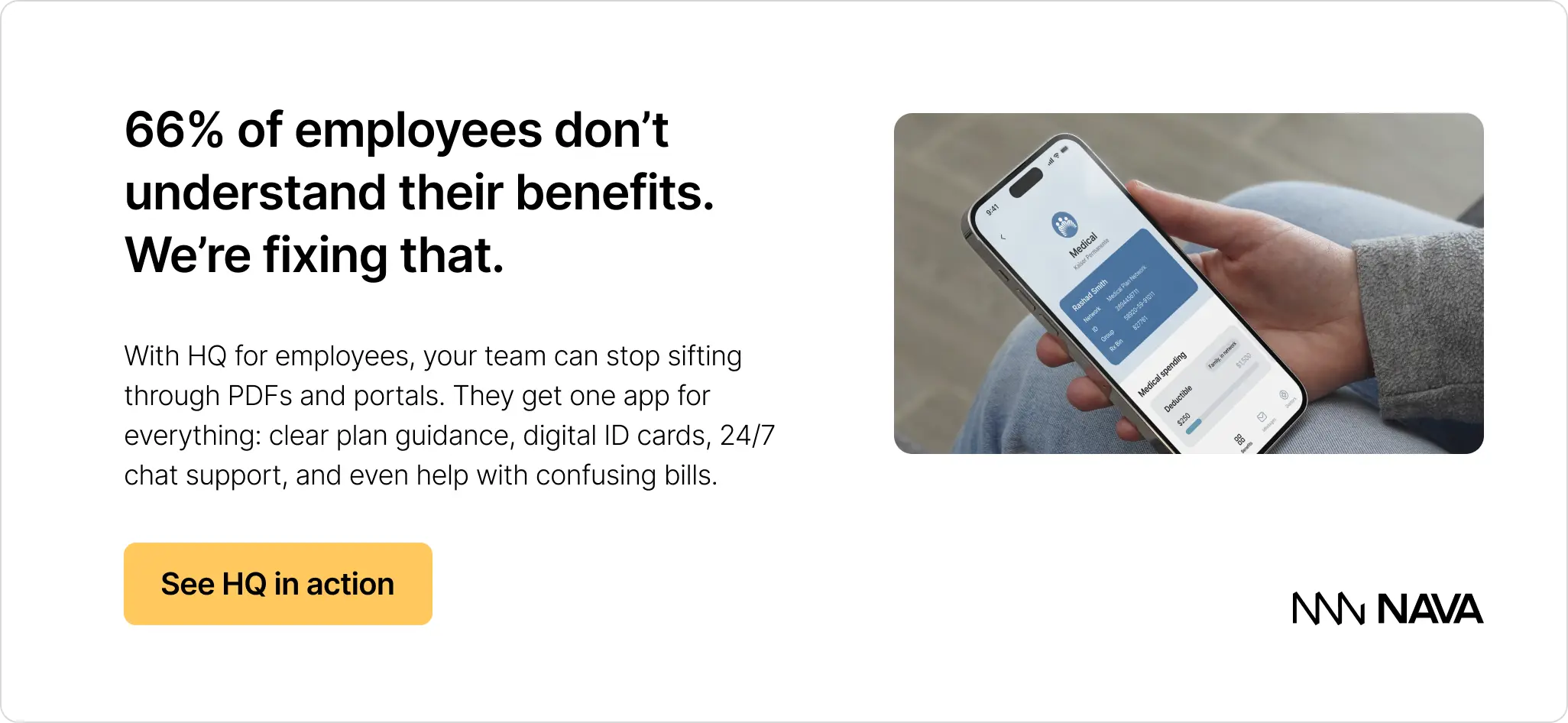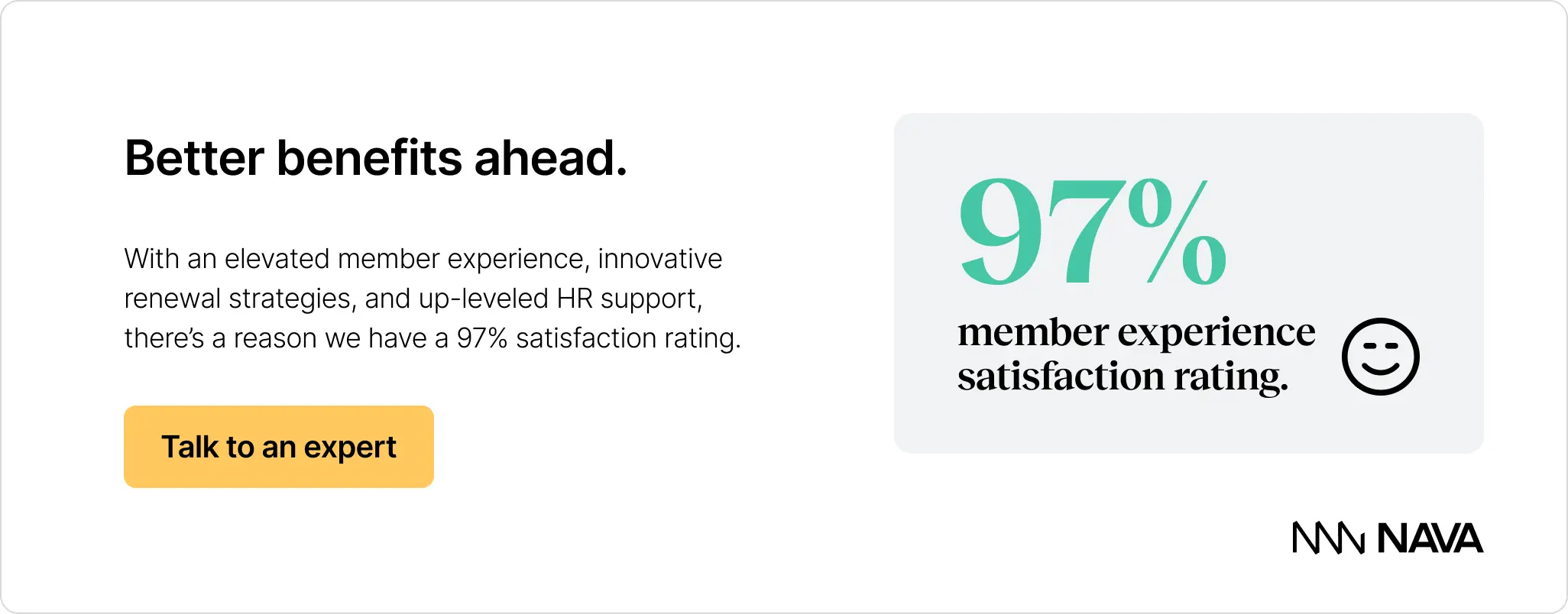Your ultimate guide to employee benefits brokers
Employee benefits brokers help employers design, manage, and optimize healthcare and insurance plans for their teams. This guide explains how brokers get paid, what to look for in a partner, and how modern brokerages like Nava are combining expert consulting with technology to help HR teams simplify benefits and control costs year-round.
Employee benefits brokers play a vital role in how most Americans access healthcare. Because over 150 million Americans receive health coverage through their employer, HR leaders effectively act as the largest buyers of healthcare in the country. Yet they’re often under-resourced and overwhelmed by rising costs, confusing compliance rules, and legacy broker practices.
That’s where benefits brokers come in. The right broker acts as a strategic partner, helping HR teams design competitive plans, negotiate with carriers, and support employees year-round.
In this guide, we’ll explain what benefits brokers do, how they get paid, when it’s time to switch, and how modern brokerages like Nava are bringing transparency, technology, and proactive strategy to a system that’s long overdue for change.
What does an employee benefits broker do?
An employee benefits broker is a licensed professional or firm that helps employers evaluate, purchase, and manage benefit plans like health, dental, vision, life, and disability insurance.
A benefits broker’s job goes far beyond securing insurance quotes. The best brokers act as long-term partners who help employers manage renewals, open enrollment, compliance, and employee support year-round. Here are the main ways employee benefits brokers can offer support:
1. Healthcare renewals
Your broker should make renewal season efficient and collaborative. While most brokers have access to the same carriers and plans, their real value lies in how well they anticipate changes, analyze data, and design a sustainable benefits strategy.
A strong broker will:
- Deliver renewal information early enough to make informed changes
- Recommend plan adjustments based on utilization and employee needs
- Propose cost-saving and alternative funding strategies (like level-funded or self-insured options)
- Handle carrier negotiations transparently
2. Open enrollment
Open enrollment (OE) is one of HR’s most visible and time-intensive projects. A proactive broker helps HR lead the process confidently while educating employees about how to use their benefits.
They should:
- Provide clear communication templates and educational materials
- Offer digital tools for easy enrollment, such as portals or mobile apps
- Ensure compliance with enrollment deadlines and disclosures
- Support HR with real-time answers to employee questions
Only about 4 in 10 Americans feel very confident choosing a health plan. A great broker helps bridge that gap with clear education and guidance.
3. Compliance support
Compliance is complex and constantly changing. A great broker protects your organization by keeping you informed and organized.
They should:
- Track evolving ACA and ERISA requirements
- Maintain digital compliance calendars and filing systems
- Conduct audits and flag potential risks early
- Provide clear guidance on notices, reporting, and documentation
4. Year-round employee advocacy and support
Benefits shouldn’t end after open enrollment. The right broker provides ongoing support to help employees understand and use their plans effectively which, in turn, saves HR time.
They should:
- Respond quickly to employee questions
- Help employees resolve claims or coverage issues
- Offer educational tools to drive benefits literacy and plan utilization

How do employee benefits brokers get paid?
Most brokers are compensated in one of two ways:
Commission-based model:
The broker earns a percentage of premiums paid to the carrier. This model doesn’t require an upfront cost to the employer, but it can make it harder to see the true cost of service or potential incentives from carriers.
Fee-based model (also called fee-for-service):
The employer pays a flat or per-employee fee directly to the broker. This approach offers full transparency and predictable budgeting, though it requires clear agreement on the scope of services.
The CAA and what it means for employers:
The Consolidated Appropriations Act (CAA) of 2021 introduced new transparency requirements for employee benefits brokers and consultants. Under the law, brokers must disclose all direct and indirect compensation they receive from insurance carriers or other vendors.
For employers, this means you now have a legal right — and responsibility — to understand exactly how your broker is paid and whether any potential conflicts of interest exist.
Tip: Always ask your broker to provide a written compensation disclosure as part of your renewal process. Modern brokers like Nava already build transparency into every client agreement, so there are no hidden tech fees or carrier incentives.
Broker vs. consultant: What’s the difference?
The terms broker and consultant are often used interchangeably, but they aren’t quite the same.
- A broker typically focuses on buying and managing insurance plans, ensuring compliance, and handling renewals.
- A consultant focuses on strategy, including things like plan design, benchmarking, and long-term cost control.
In today’s market, the best brokerages combine both roles. They provide strategic consulting and proactive management so employers don’t have to choose between expertise and execution. That’s the model Nava was built on.
How to find the right benefits broker
Selecting the right broker is one of the most important HR partnerships you’ll make. The best brokers do more than secure competitive rates — they act as an extension of your HR team, helping you manage costs, stay compliant, and support employees year-round.
Here’s what to look for when evaluating potential partners:
- A proactive, year-round approach.
- Your broker should meet with you regularly to review plan performance, not just appear at renewal time. Proactive brokers use data, benchmarking, and forecasting to help you make smarter, faster decisions.
- Strong client support and employee advocacy.
- Ask how quickly they respond to issues and whether they offer direct employee support. A great broker takes work off HR’s plate and ensures employees get help when they need it most.
- Technology and reporting tools.
- Modern brokerages use digital platforms to model renewals, manage compliance, and provide employees 24/7 access to their benefits. These tools give HR real-time visibility and save hours of manual work every week.
- Experience with companies like yours.
- Ask what industries and company sizes they serve. A broker who understands your growth stage and workforce demographics can deliver more relevant benchmarking and smarter plan design.
- Alignment with your values.
- Look for a partner who shares your commitment to clarity, affordability, and employee wellbeing — not just cost savings. The best relationships are built on shared goals and trust.
- Transparent compensation.
- Under the Consolidated Appropriations Act (CAA), brokers must disclose how they’re paid. The most trustworthy firms go further, proactively sharing fee structures and potential incentives up front.
At Nava, we believe the best broker relationships are built on transparency, technology, and trust. When your broker acts as an extension of your HR team, you get more than a benefits plan — you get a strategy.
When should you switch brokers?
If your current broker only calls once a year at renewal, it may be time to look elsewhere. Common signs it’s time to switch include:
- No proactive renewal strategy or data insights
- Limited access to technology or reporting tools
- Slow response times or poor employee support
- Rising costs without clear explanations
- Missed compliance deadlines or filing errors
The benefits broker landscape: traditional vs. modern models
The brokerage industry has changed significantly. Employers today can choose from three main types of brokers:
Traditional brokerages
Firms like Gallagher, Mercer, and USI have decades of experience and strong carrier relationships, which have made them trusted partners for many employers. Their scale and institutional knowledge bring stability, but their processes were built for an earlier era of benefits management.
Most traditional brokerages still rely on manual systems, spreadsheets, and an annual renewal cycle focused on rate negotiations rather than ongoing strategy. While this model works for some organizations, it often leaves HR teams without the real-time insights or proactive guidance needed to manage today’s rising costs and employee expectations.
Tech-forward brokerages
Modern brokerages like Nava, Sequoia, and Newfront are redefining how employers manage benefits by combining expert consulting with technology that helps HR teams thrive and scale.
These firms go beyond spreadsheets and annual renewals to offer digital platforms that centralize plan data, automate manual tasks, and provide real-time insights into cost trends and plan performance. The result is a more transparent, proactive experience for both HR and employees.
At Nava, our HQ platform serves as a command center for benefits. It gives HR leaders the tools to model renewals, audit plans for errors, and get answers to complex benefits questions in seconds. The platform is designed to eliminate administrative burden, empower better decisions, and create space for HR teams to focus on people rather than paperwork.
This tech-enabled model represents the next generation of brokerage. It blends human expertise with automation and data visibility to help mid-sized employers access the same level of strategy and sophistication once reserved for the Fortune 500.
Digital-only or point solutions
Companies such as Nayya, HealthJoy, and Healthee represent a growing category of digital-first benefits tools. These platforms enhance the employee experience through decision support, plan guidance, and navigation tools that make benefits easier to understand and use.
Unlike full-service brokerages, these solutions don’t manage renewals, negotiate with carriers, or provide compliance strategy. Employers often pair them with a broker to cover those needs.
.webp)
Why employers are moving toward modern brokerages
Healthcare costs keep rising. HR teams are stretched thin. Employees expect more clarity and support than ever before.
That’s why many employers are leaving legacy brokers for modern partners who offer:
- Data transparency: real-time plan insights instead of static spreadsheets
- Proactive strategy: year-round planning and cost modeling, not just annual renewals
- Technology that works: tools that simplify administration and reduce HR workload
- Human expertise: dedicated consultants who act as an extension of your team
Frequently Asked Questions
Do I need a broker for a small business?
Yes. A licensed broker can negotiate better rates, manage compliance, and save time, even for teams under 50 employees.
Can I change brokers mid-year?
Yes. Your insurance carrier contract stays intact. You can appoint a new broker at any time with a Broker of Record (BOR) letter.
How much do brokers cost?
Most brokers earn 2–10% commission on premiums or charge a flat per-employee fee. Always request full compensation disclosure.
How is a modern brokerage different?
Modern brokers like Nava integrate technology, automation, and transparent pricing — replacing spreadsheets with real-time insights and support.
What’s the difference between a broker and a consultant?
A broker helps you buy and manage insurance plans, while a consultant focuses on benefits strategy and plan design. Modern brokerages combine both roles, offering hands-on management and strategic guidance throughout the year.
Are brokers required to disclose their compensation?
Yes. Under the Consolidated Appropriations Act (CAA) of 2021, brokers must disclose all direct and indirect compensation before you sign a contract. This includes commissions, vendor payments, and potential carrier incentives.
What happens during renewal season with a broker?
Your broker should review plan performance, model cost scenarios, and negotiate with carriers on your behalf. Proactive brokers start this process months in advance so you can make informed decisions and avoid last-minute surprises.
Do brokers help with compliance?
Yes. Most brokers assist with ACA and ERISA requirements, but the level of support varies.
Key Takeaways
- A benefits broker helps employers design, buy, and manage benefit plans.
- Always ask how your broker gets paid. Transparency matters.
- Watch for warning signs like limited service or poor communication.
- Choose a partner that combines expert consulting with technology.
- Modern brokerages like Nava deliver clarity, control, and better outcomes for HR teams and employees alike.
Ready to See What a Modern Brokerage Looks Like?
Discover how Nava helps employers control healthcare costs, reduce admin time, and deliver a better employee experience — all year long.



